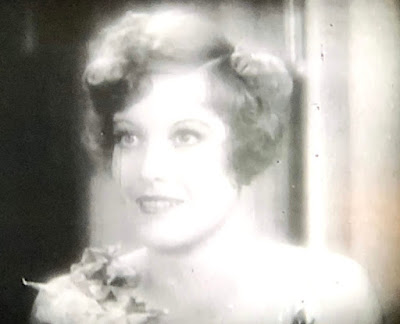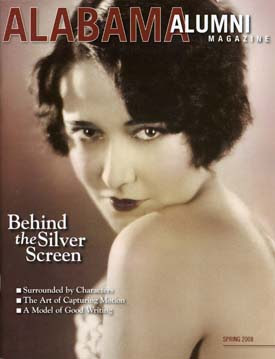I've written before on this blog about two Alabama natives who went Hollywood, Dorothy Sebastian and Johnny Mack Brown. In this post I'm going to examine a 1928 silent film they made together, Our Dancing Daughters, a portrait of youth during the roaring, immoral twenties. The film also starred Joan Crawford, Anita Page and Nils Asther and was a financial success. Crawford's first film had been released in 1925; this one made her a star.
The story unfolds among the parties, romances, and leisure activities of a group of young people moving in wealthy circles. Diana [Crawford] and Ann [Page] are best friends who meet the wealthy Ben [Brown] at one of their apparently frequent parties at the yacht club. Diana and Ben are immediately attracted to each other, but Ann soon makes her move. Diana has a "wild girl" reputation that sours Ben on her, and he marries the supposedly virginal Ann. We also watch the relationship between a third friend Beatrice [Sebastian] and another wealthy beau, Norman [Nils Asther]. Let's just say complications ensue. You can read Wikipedia's more detailed plot description here.
I enjoyed this film, which is only 86 minutes long. Watching Alabama natives acting in early Hollywood is always fun, and the story moves along at a rapid pace. I've seen enough silent films over the years that I'm comfortable watching them.
Brown married Cornelia Foster in 1926, and they remained married until his death in 1974. They had four children. For more on him, see Beidler, Phillip D. "The Story of Johnny Mack Brown." Alabama Heritage 38 (Fall 1995): 14-25
Sebastian, on the other hand, cut a different path through Hollywood. She was married three times; the first husband was her high school sweetheart; that marriage ended in 1924. Husband number two was William "Hopalong Cassidy" Boyd; they married in 1930 and divorced six years later. The third marriage lasted until her death in 1957. She was briefly engaged to Clarence Brown, who just happened to operate a car dealership in Birmingham before his long career as a film director began. Sebastian also had an affair with Buster Keaton in the 1920's while he was married to Norma Talmadge. The affair may have resumed after she and Boyd were divorced. Sebastian was arrested for drunk driving in 1938 after a dinner at Keaton's also attended by her nephew.
See more comments below many of the stills. Reviews, commentary and more images related to the film can be found here. Brown and Sebastian both have stars on the Hollywood Walk of Fame.
MGM tried to turn Brown into a leading man and went with the "John Mack Brown" name for a while. He made top of the line films with Mary Pickford, Joan Crawford and Jean Harlow for a few years, but then was replaced by some rising young star named Clark Cable. Brown, who had already made a few westerns, moved into that genre completely and had a career that lasted into the 1960's. He made over 160 films before he retired from the screen. Brown tested for the role of Tarzan in the 1932 film, but the director thought he was too short.
In the opening scenes we see inside the house where Diana lives with her parents. Here they are talking in mum's bedroom before Diana heads out to yet another Yacht Club party. The Art Deco sets in this film are to die for....
At a massive party at the Yacht Club Diana cuts a rug or three.
Meanwhile, Beatrice & Norman are outside in his car yakking. Norman wants to get married, Beatrice is resisting. This scene is the first time we see Sebastian in the film. Sebastian appeared in about sixty movies between 1925 and 1948, although most of those in the last decade or so used her in small roles.
We have to wait a bit to find out why Sebastian is so reluctant.
Ben lights up when he first sees Diana on the dance floor.
Brown, of course, really did play halfback at Alabama and his performance in the 1925 Rose Bowl helped the team win a national championship. Brown's image on Wheaties cereal boxes soon followed, and he was invited to do a screen test in Hollywood in 1927. Brown was from Dothan, though, not Birmingham.
Diana responds immediately when she sees Ben and learns his status.
There's lots of clever dialog in this film.
Ben's initial interest in Diana is quickly overcome by Ann, the supposed "good girl" of the pair. Ben has no interest in the soiled dove Diana, who has a "party girl" reputation, so he ends up marrying Ann.
Oh, now we're back to Beatrice and Norman and their discussion in the car.
Beatrice finally confesses--she had sex with other men before she met Norman!
Norman goes on to ask, "Were--they--of our crowd?" Beatrice is reluctant to answer, and then he declares he doesn't want to know. Then the kissing begins.
After a day of horseback riding with the gang, Diana and Beatrice have some fun with boots.
At yet another Yacht Club party--ho, hum--the two Alabama natives have a chance to get together for a little talking. I wonder what interesting conversations they had on the set during filming.
After Bea & Norman are married, Diana goes to visit. Some of Bea's exes tag along.
"Here's to the husbands--of the girls we love."
After breaking a glass, Norman offers a toast of his own: "Here's to the lovers--of the girls we marry." Bea is embarrassed, Diana embarrassed for her, and the exes make a quick retreat.
"Norman--you must forget--trust me!" They kiss and make up, but Norman declares, "I love you--then I hate you--then I love you again--"
Diana comforts Bea by telling her that Norman will be back. Bea says "Yes--and all through our lives together--he'll be coming back--then leaving me again." Then she tells Diana to thank God she hasn't done "anything that can come back afterward and punish you."
In much of the rest of the film we follow the marriage of Ben and Ann as it spirals downward. "Good girl" Ann is a lush and cheats on Ben continuously. In the end, however, Ben becomes free to marry his true love--the real good girl Diana.
The four photographs below are publicity stills for the film.
Sebastian and Asther made the cover of True Romances for November 1932. I'm not sure what it appeared four years after the movie.
Source: Nils Asther fan blog
Sebastian and Asther in a photo by Ruth Harriet Louise, portrait photographer at MGM. Look familiar?
Source: Nils Asther fan blog
Sebastian made the cover of the Alabama Alumni Magazine spring 2008 for Catherine Gwaltney's article "So You Want to Be In Pictures" which examined Sebastian and Johnny Mack Brown's lives and careers in Hollywood. Sebastian briefly attended the University of Alabama before marrying Allen Stafford in Nobvember 1920.



















































